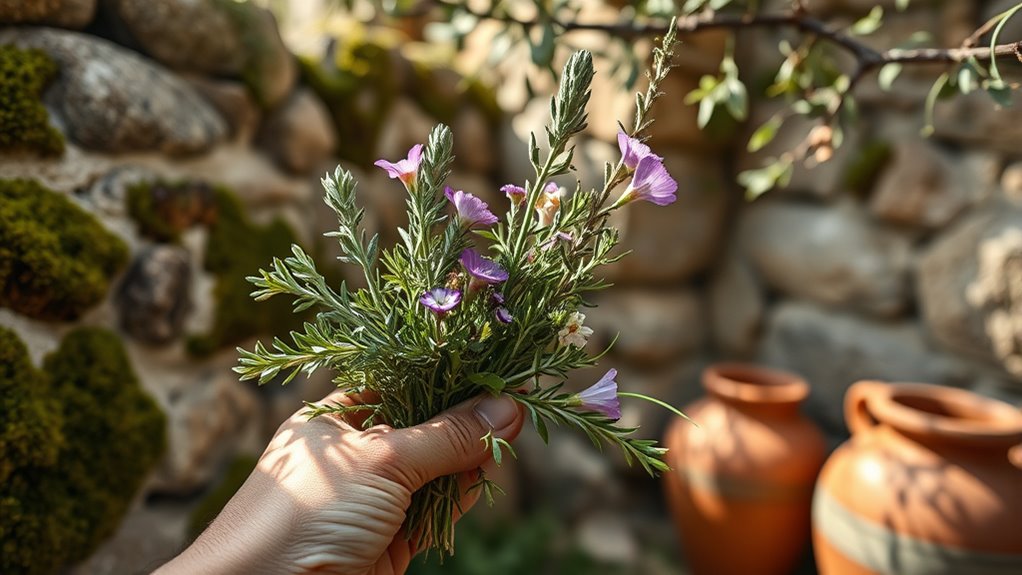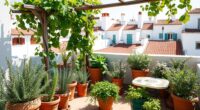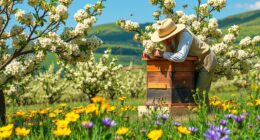Sardinian plant medicine is a rich, living tradition rooted in ancient knowledge passed down through generations. It combines herbal remedies, oral traditions, and cultural practices influenced by Greek, Phoenician, and Roman civilizations. You’ll find that local plants like myrtle, thyme, and prickly pears play a key role in healing common ailments like digestion and respiratory issues. To explore how these practices sustain Sardinian culture and ecology today, keep exploring what makes this heritage unique.
Key Takeaways
- Sardinian plant medicine has deep roots in ancient texts like Dioscorides and oral traditions passed through generations.
- Local flora such as myrtle, thyme, and helichrysum play a central role in traditional healing practices.
- Remedies primarily target digestive and nervous system ailments using infusions, decoctions, and ritual practices.
- Cultural heritage is preserved through mentorship, storytelling, and rituals like ‘Su Purtidu’ that reinforce community bonds.
- Conservation of endemic plants and sustainable harvesting are vital for maintaining biodiversity and traditional medicinal knowledge.
Roots of Sardinian Healing: A Historical Perspective
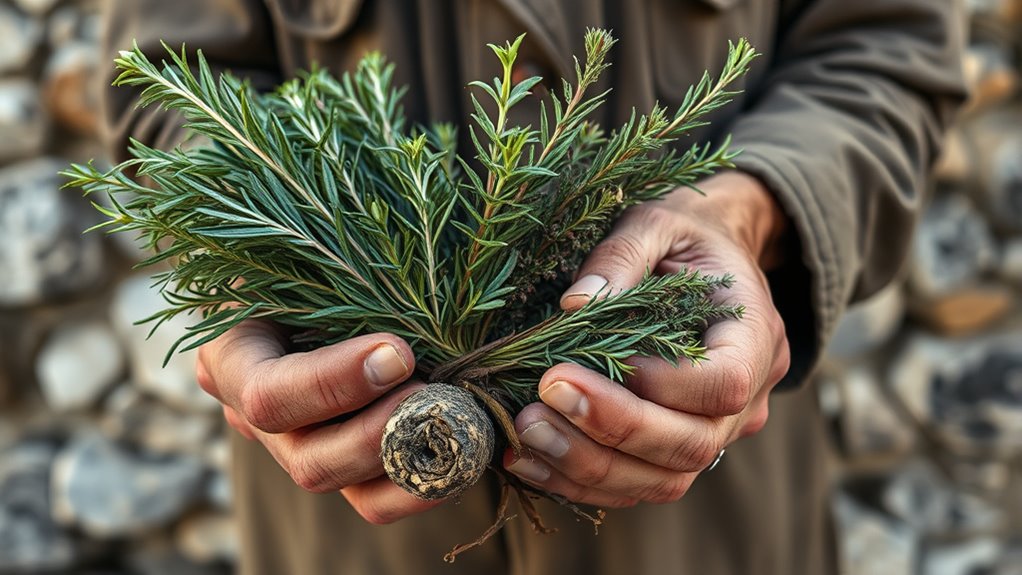
The roots of Sardinian healing traditions run deep, shaped by a rich tapestry of historical influences and enduring practices. You’ll find that Sardinian medicinal plant use draws heavily from classical sources like Dioscorides’ *De Materia Medica*, which shaped regional knowledge for centuries. This continuity links Sardinia’s plant use with broader Mediterranean traditions, reflecting shared ancient practices. Unlike purely oral traditions, much of this knowledge was recorded in written texts and passed down through generations of herbalists and scholars. Sardinia’s relative isolation helped preserve these practices, creating a unique healing culture distinct from mainland Italy and the wider Mediterranean. Over time, influences from Phoenician, Punic, and Roman civilizations melded into a resilient tradition that remains embedded in the island’s cultural identity today. Additionally, the written documentation of these practices has played a crucial role in maintaining and transmitting Sardinian herbal knowledge across generations.
The Most Used Medicinal Plants of Sardinia

Among Sardinia’s diverse landscape, certain medicinal plants stand out for their widespread use and cultural significance. Myrtle is valued for its wellness properties, often used to treat various health issues. Prickly pears, rich in antioxidants, help with skin conditions and reduce inflammation. Thyme is a staple herb, known for aiding digestion and respiratory health. Helichrysum is prized for its anti-inflammatory qualities and is used in skin treatments and cough relief. Rosemary is popular for supporting cognitive function and digestion. These plants are deeply embedded in local traditions and continue to be an integral part of Sardinian healing practices. Their phytochemical properties, such as essential oils and antioxidants, make them versatile remedies. Many of these plants are harvested sustainably using traditional methods that preserve their natural populations, ensuring their availability for future generations. Additionally, understanding the emotional energy involved in traditional healing may enhance the effectiveness of these natural remedies.
Common Ailments and Plant-Based Remedies

Have you ever wondered how Sardinian traditional medicine addresses common health issues? About a third of treatments focus on digestive problems like diarrhea, constipation, and spasms. Plants with antidiarrheal, laxative, and antispasmodic properties are used to provide relief. Myrtle, or Mirto, is popular for soothing digestion and gastrointestinal comfort. Lemon verbena and thyme infusions help calm upset stomachs and promote digestion. Typically, decoctions and infusions are prepared to maximize absorption of these plant compounds. For nervous system ailments, plants like lemon verbena and Helichrysum are used as teas or tinctures to reduce stress, relieve pain, and support nerve health. These remedies are simple, natural, and tailored to address common conditions, emphasizing the healing power of Sardinian flora in everyday health management. Herbal remedies have been handed down through generations, reflecting the island’s rich botanical heritage. Additionally, incorporating modern heat pump technology can improve the efficiency and comfort of home environments, paralleling traditional practices by enhancing well-being through innovative solutions.
The Ecological and Cultural Significance of Sardinian Flora
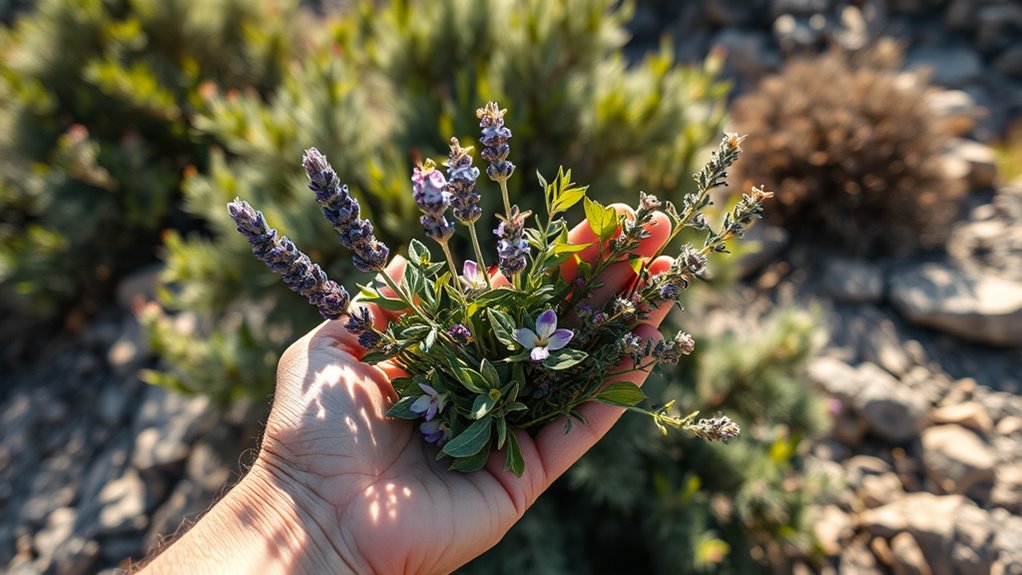
You can see how Sardinian flora is crucial for preserving biodiversity and maintaining ecological balance on the island. These native plants also carry deep cultural meanings, reflecting Sardinia’s history and traditions. Protecting them ensures both environmental health and cultural heritage stay strong for future generations. Moreover, their unique climate fosters diverse plant species that possess healing properties, further emphasizing their ecological and cultural importance. Additionally, the native plant species are vital for supporting local ecosystems and traditional medicinal practices.
Biodiversity Conservation Importance
Sardinian flora holds immense ecological and cultural importance due to its high level of endemism and unique biodiversity. About 15% of its native plants are endemic, with 341 taxa found only in the Tyrrhenian Islands, supporting diverse ecosystems like coastal garrigue and mountainous habitats. These plants play an essential role in maintaining ecological balance, supporting pollinators, preventing soil erosion, and conserving water. Many species are sensitive indicators of environmental health, making their preservation critical. However, habitat loss from agriculture, urbanization, and climate change threatens their survival—25 taxa are critically endangered. Protected areas, legal frameworks like the EU Habitat Directive, and sustainable practices are indispensable to conserve these endemic species. Preserving Sardinia’s biodiversity ensures ecological resilience and sustains the cultural traditions linked to its plant heritage. Endemic species are particularly vulnerable to habitat destruction, emphasizing the need for targeted conservation efforts.
Cultural Heritage Preservation
The rich biodiversity of Sardinian flora is deeply woven into the island’s cultural fabric, especially through its traditional plant medicine practices. You draw from ancient texts like Dioscorides’ *De Materia Medica*, maintaining a continuous link between classical knowledge and local remedies. Oral traditions have preserved this knowledge across generations, blending with written records to strengthen cultural identity. About 170 medicinal species form the core of Sardinia’s ethnopharmacopoeia, often including common, non-threatened plants used sustainably. Rituals like ‘Su Purtidu’ intertwine spiritual and medicinal plant use, reinforcing community bonds. Additionally, the emphasis on sustainable harvesting practices ensures the continued availability of these vital botanical resources for future generations. Below is a table illustrating the connection between ecological preservation and cultural identity:
| Ecological Significance | Cultural Heritage Preservation |
|---|---|
| Abundant medicinal herbs from unique climate | Traditional knowledge passed orally and in texts |
| Sustainable use of common, non-threatened plants | Rituals reinforce communal participation |
How Knowledge of Plant Medicine Is Passed Down

You learn Sardinian plant medicine mostly through oral stories and hands-on practice within families, especially from elder women. Written texts like ancient Greco-Roman scripts also influence how knowledge is shared and remembered. Together, these methods keep traditional healing practices alive across generations. Understanding Gold IRA Rollovers can also provide insight into how traditional and modern investment knowledge are passed down and preserved.
Oral Transmission Practices
Knowledge of plant medicine in Sardinia is mainly passed down through oral tradition, with elders and healers serving as the key transmitters. You learn through storytelling, observation, and hands-on practice, ensuring the knowledge stays alive across generations. Elders and herbalists act as custodians, demonstrating plant identification, collection, and preparation techniques directly to apprentices. Their mentorship often takes place in informal settings like family gatherings, community rituals, or healing ceremonies. Mnemonic devices, ritual language, and local dialects help preserve complex herbal lore. Respect for elders sustains this tradition, but it faces risks from modernization, demographic shifts, and the decline of knowledgeable practitioners. Despite challenges, this oral system remains a essential, adaptable way to keep Sardinian healing knowledge vibrant and culturally rooted. This transmission method helps maintain the diversity of traditional practices in Sardinia.] Additionally, the use of local dialects plays a crucial role in transmitting nuanced herbal knowledge that might not be captured in written form.
Influence of Written Texts
Historical texts have played a crucial role in shaping Sardinian plant medicine by providing a written record that complements oral traditions. Dioscorides’ *De Materia Medica*, written in the 1st century AD, remains influential, with its widespread translations and references shaping local pharmacopoeias. This legacy is reinforced through cross-validation of traditional species with ancient texts, ensuring authenticity. The table below highlights key aspects of this influence:
| Aspect | Description | Impact |
|---|---|---|
| Classical References | Dioscorides’ work guides medicinal plant use | Enduring regional influence |
| Cultural Transmission | Greek as a lingua franca helped knowledge spread | Preservation of traditions |
| Modern Parallels | Contemporary uses mirror ancient indications | Continuity of healing practices |
Additionally, the transmission of botanical knowledge has been facilitated through both written and oral means over centuries, maintaining the integrity of traditional practices. This textual legacy enriches Sardinian healing traditions, blending history with modern practice.
Modern Science Meets Ancient Wisdom in Sardinian Ethnobotany
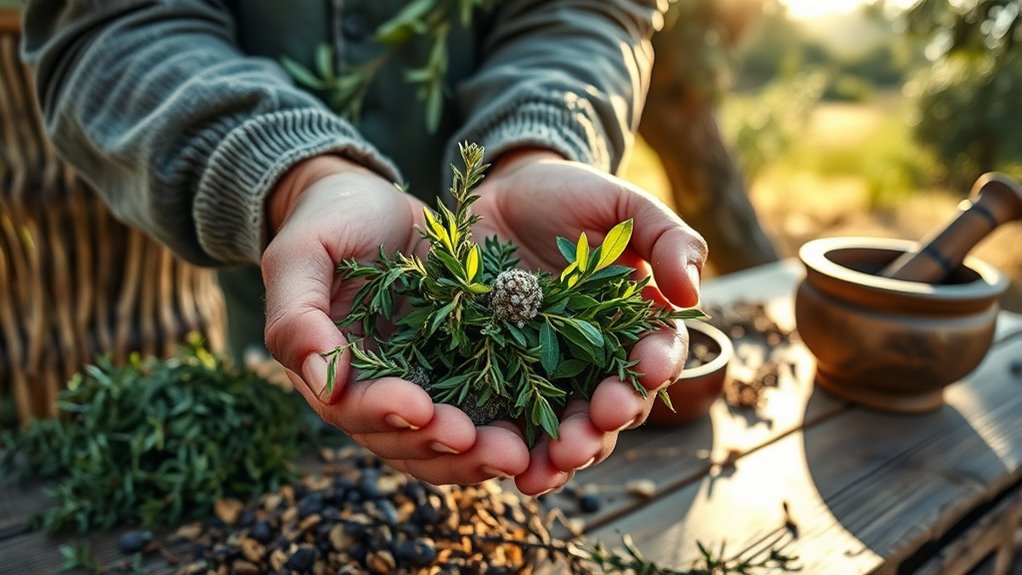
Modern science is increasingly validating the centuries-old medicinal practices of Sardinian communities by systematically analyzing their native plants. With Sardinia’s high biodiversity and endemic species, researchers identify active compounds that support traditional uses. The Marmilla subregion alone hosts 137 medicinal plants, many used for skin, digestive, and respiratory ailments. Ethnobotanical knowledge varies across villages, but ongoing studies confirm the efficacy of local flora. Modern techniques like phytochemical and pharmacological analyses help uncover bioactive substances, linking traditional remedies to scientific evidence. Collaborations between ethnobotanists and locals promote sustainable use and conservation. This integration preserves Sardinian healing wisdom while opening doors to new therapies. Despite challenges like habitat loss and depopulation, scientific efforts continue to bridge ancient knowledge with modern medicine, ensuring these practices endure. Furthermore, ongoing research actively documents and preserves traditional knowledge for future generations.
Preserving a Living Heritage: Challenges and Opportunities

Sardinia’s remote landscapes have helped preserve traditional botanical practices, but ongoing demographic and environmental shifts threaten this living heritage. Rural depopulation and migration reduce the number of knowledge holders, especially in areas like Marmilla, where fewer practitioners and younger generations leave. Environmental threats, such as climate change and habitat degradation, endanger endemic medicinal plants crucial for healing traditions. These plants are vital for maintaining the island’s holistic health practices and cultural identity. Challenge | Impact | Solution |
| — | — | — |
|---|---|---|
| Population decline | Fewer transmitters of knowledge | Promote community documentation and traditional plant knowledge preservation initiatives |
| Habitat loss | Reduced plant availability | Strengthen conservation efforts |
| Limited research | Fragmented knowledge base | Support extensive ethnobotanical studies |
You face a pressing need to preserve this cultural and ecological wealth before it’s lost forever.
Frequently Asked Questions
How Has Sardinian Plant Medicine Influenced Modern Mediterranean Pharmacology?
You see, Sardinian plant medicine has considerably shaped modern Mediterranean pharmacology. Its traditional use of about 170 key species aligns with ancient texts like Dioscorides’ *De Materia Medica*, influencing herbal formulations today. By validating traditional remedies through scientific research, you can appreciate how Sardinian practices contribute to herbal drug development, ensuring the continued relevance of regional plants and fostering a rich, evidence-based herbal medicine tradition across the Mediterranean.
Are Any Sardinian Medicinal Plants Endangered Due to Traditional Harvesting?
You should know that several Sardinian medicinal plants are endangered because of traditional harvesting. For example, Hypericum scruglii faces risks from unsustainable wild collection, threatening its survival. Many endemic species, including those used in traditional medicine, are at risk due to overharvesting and habitat disturbance. Without proper regulation and conservation efforts, these plants could disappear, impacting both local ecosystems and the traditional practices that depend on them.
What Role Do Written Texts Play in Preserving Sardinian Healing Knowledge?
You might wonder how written texts help preserve traditional healing knowledge. They serve as vital references, ensuring that medicinal plant use remains consistent across generations. By documenting plant classifications, uses, and therapeutic applications, these texts provide stability and scholarly authority. They also enable you to compare modern practices with historical sources, helping protect cultural heritage and prevent loss of valuable plant-based knowledge, even as oral traditions evolve or fade.
How Do Specific Plants Correlate With Dioscorides’ Descriptions?
This question cuts to the heart of ancient herbal wisdom, a treasure trove you can still tap into today. You compare Sardinian plants like *Carlina gummifera* and *Ephedra distachya* with Dioscorides’ descriptions, matching features and uses. By analyzing botanical traits and chemical properties, you find a fascinating link that preserves centuries-old practices, proving these plants’ roles in traditional medicine are as crucial now as they were millennia ago.
Can Sardinian Traditional Remedies Be Validated Through Scientific Research?
You wonder if traditional remedies can be scientifically validated. Based on current research, many Sardinian plants show promising phytochemical and biological properties that support their traditional uses. Scientific studies increasingly confirm some medicinal effects, but most endemic plants need more exploration through clinical trials. Your best bet is to combine ethnobotanical knowledge with ongoing scientific efforts, which can lead to discovering safe, effective plant-based medicines rooted in centuries of cultural practice.
Conclusion
You might be surprised to learn that over 80% of Sardinians still use traditional plant remedies today. This vibrant heritage showcases how ancient healing practices continue to thrive in modern times. By embracing this knowledge, you help preserve a living tradition that connects culture, ecology, and health. Supporting Sardinian plant medicine not only honors centuries of wisdom but also promotes sustainable, natural healing for future generations.
